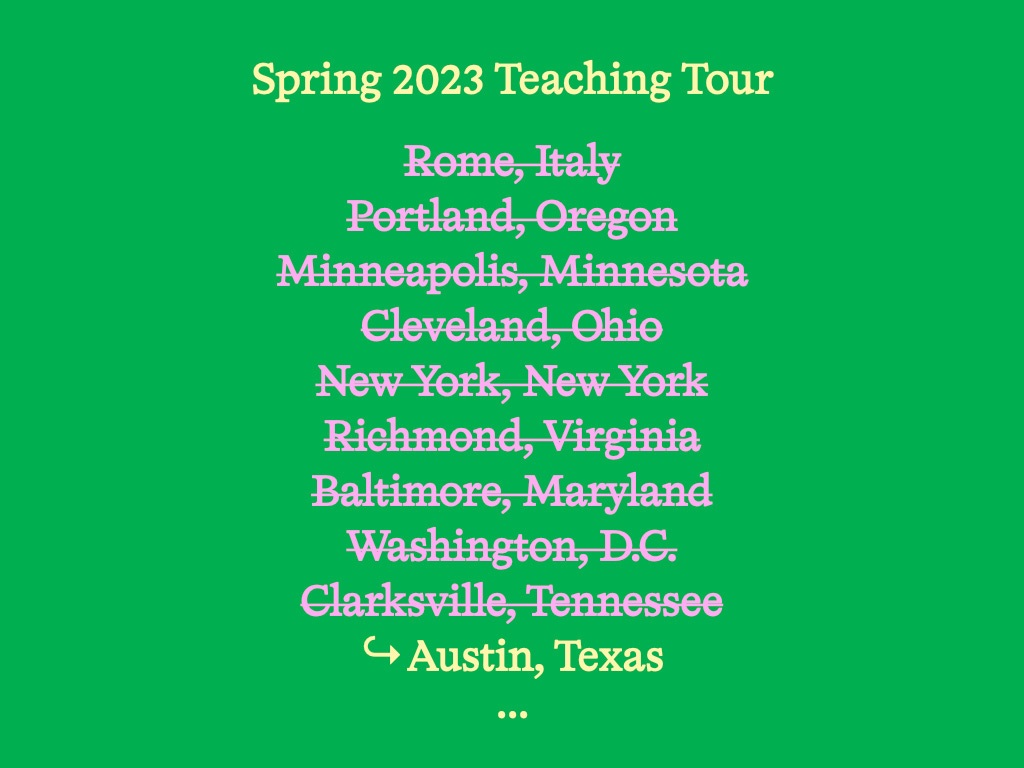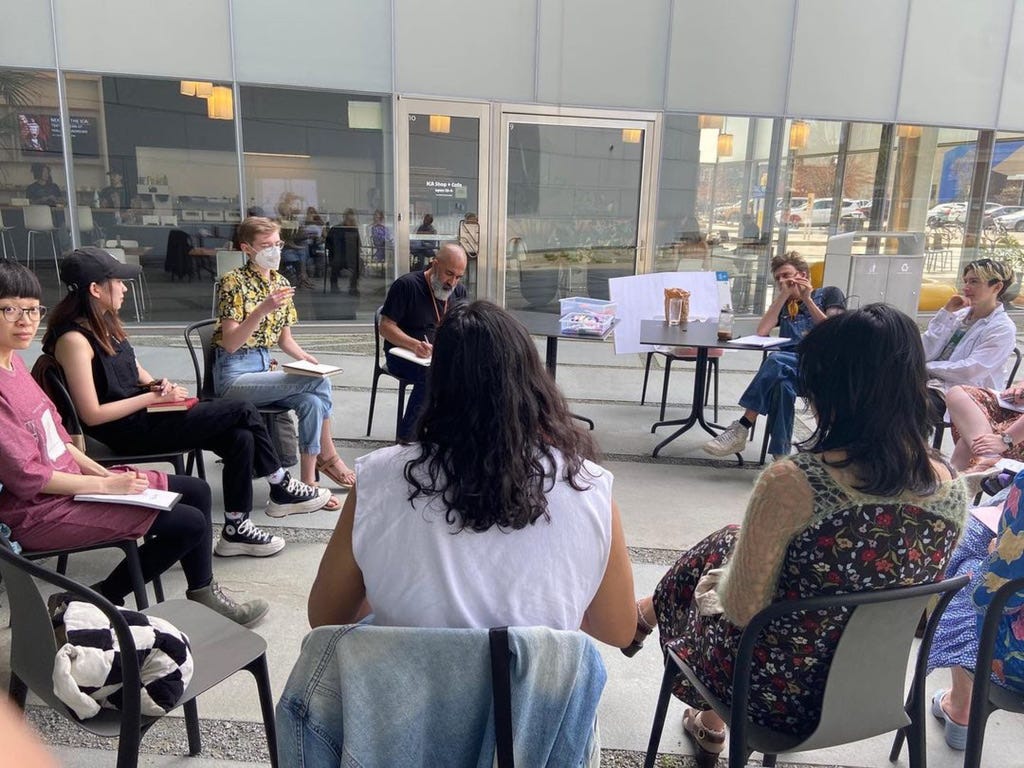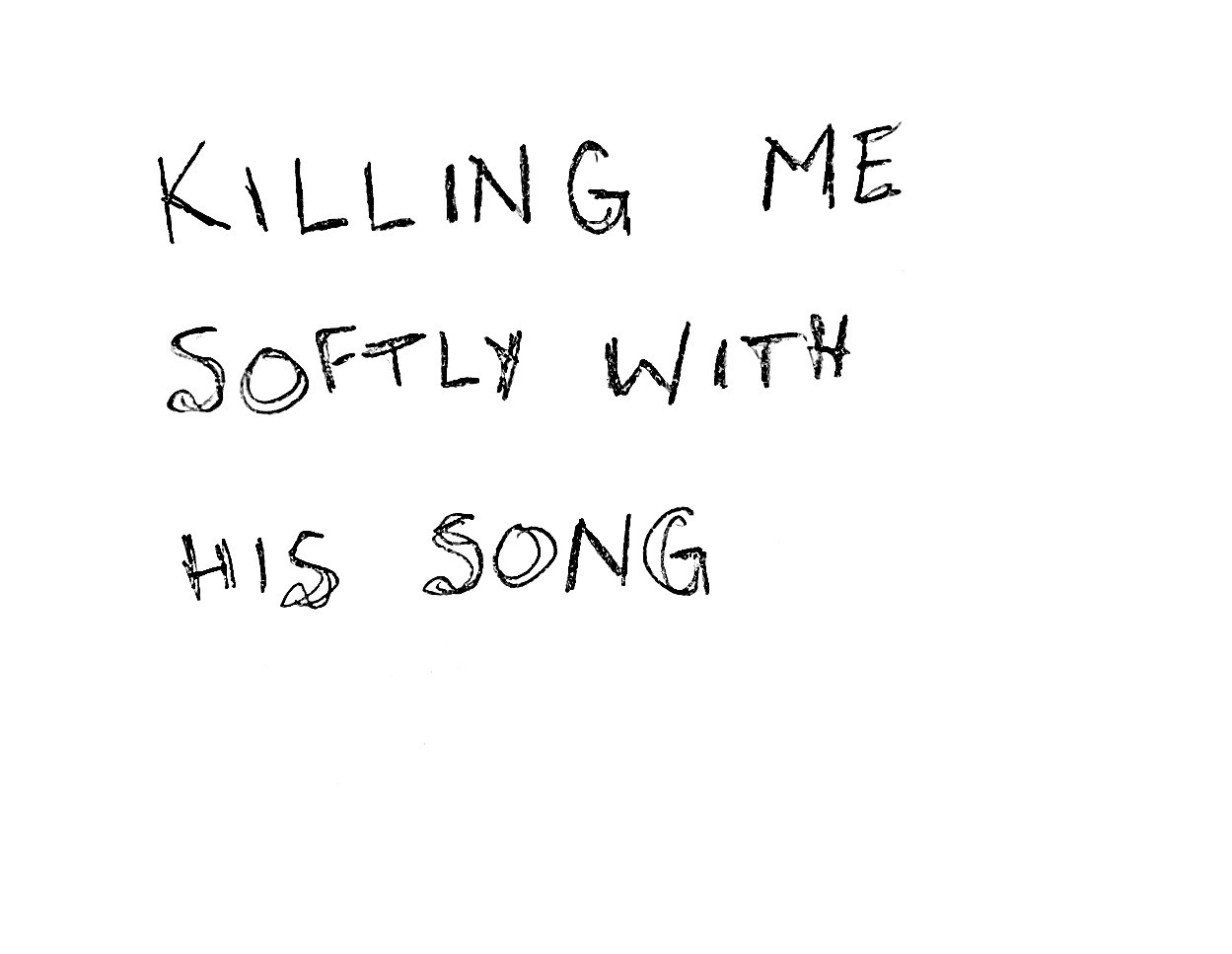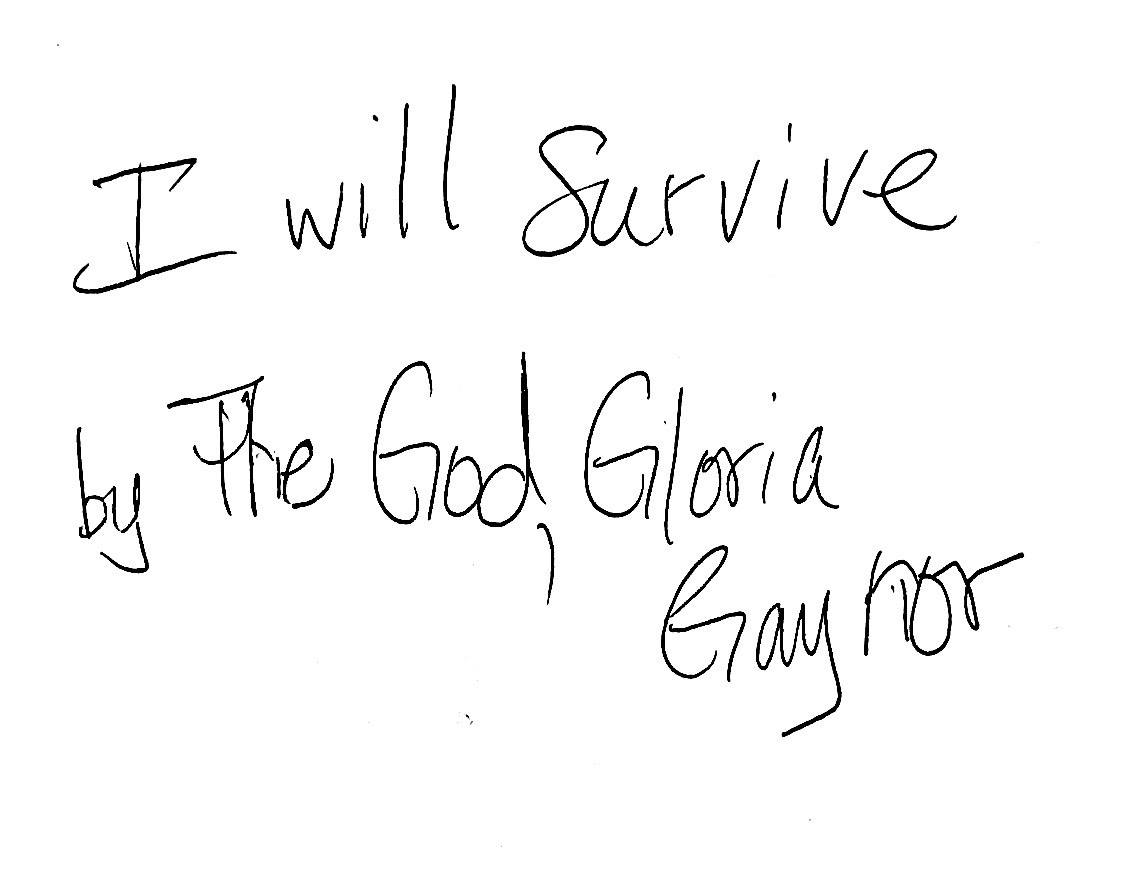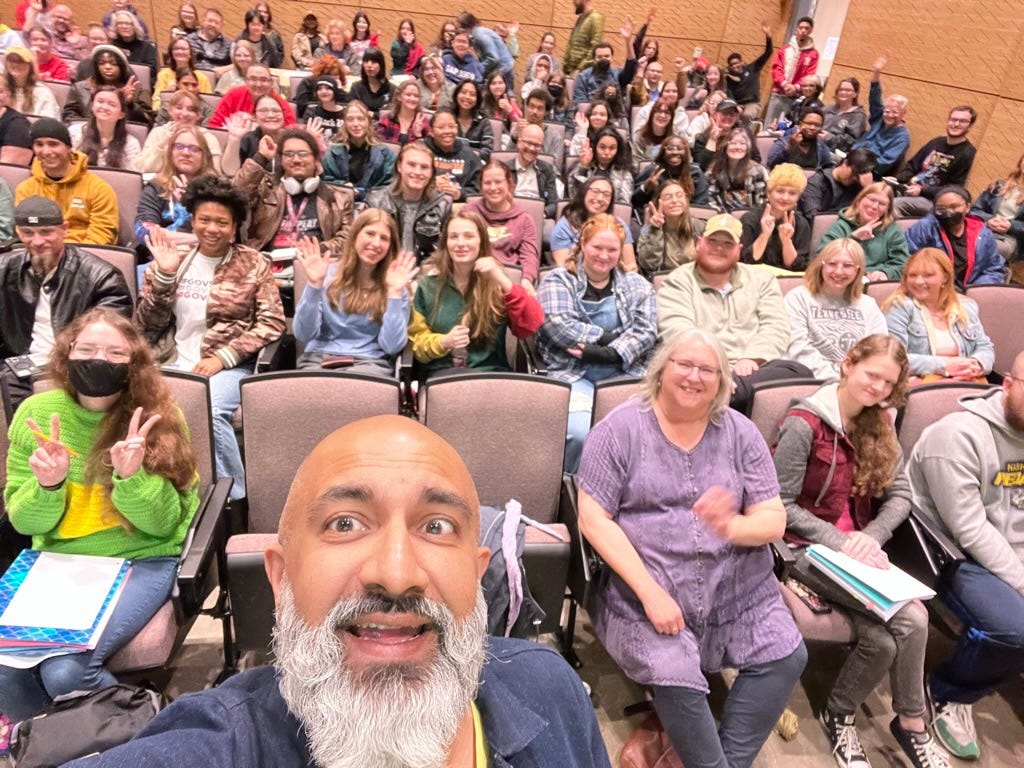Almost There
Some lessons & learnings as the D🌎T Spring Tour 2023 draws to a close
Dear friends and companions,
April is upon us, and the world’s coming back to life.
But this also means that the Department of Transformation Spring 2023 Teaching Tour is now on its last legs (or tires, as it were). Nine stops so far, only one more to go: Austin, Texas, for a five-day workshop from 12–16 April as part of the Fusebox performance festival.
This multimodal event across Austin represents the culmination of the two-month tour and will incorporate many of the lessons I’ve learned along the way. There will be a participatory-lecture-performance, a collective meal, a perambulatory conversation, a karaoke party, plus a cook-out & debrief with chana masala. It should be a wild ride!
As I prepare for this last pitstop, I’ve already begun to reflect on the process so far. Here are some of my initial takeaways:
It’s hard, hard work to go on a teaching tour. Traveling across a country, sharing creative energy with others, encountering different situations at each stop, while trying to maintain your own equilibrium—it takes both resolve and acceptance. Kae Tempest’s book On Connection chronicles this process well. Thankfully, I have fantastic companions who have helped talk me through the tough moments. I’ve also gained a newfound respect for touring musicians such as my friends The National or Mourning [A] BLKstar who have been at this for years. Kudos to you!
Humans urgently need to move beyond verbal/visual modes of relating to art as well as the world. As artist Asad Raza often tells me, it’s about engaging with the body and all of its senses. This approach helped to make the symposium that we co-organized in Washington, D.C., “How can we gather now?”, so meaningful for many of the speakers and participants. The event featured umami tasting sessions, sound baths, tea ceremonies, calligraphy demonstrations, plant-care tutorials (featuring Topo Chico!), a techno dance party, and the smell of fresh earth, alongside lectures, hybrid conversations, film screenings, panel discussions, and more. Something for every sense.
Conflict is one of the hardest topics today—the inability to deal with difference and sit with discomfort seem like major factors tearing society apart—but it’s also a subject that people are eager to explore more deeply. Sharing some of the approaches I’ve gathered from experts such as Karl Steyaert and Gabriel Kahan has been a good start, but I need to learn more tools for conflict. I recently bought Mariame Kaba & Shira Hassan’s Fumbling Towards Repair: A Workbook for Community Accountability Facilitators and am curious to explore its methods. What are your own references for dealing with conflict? I would love to know!
Methods for giving and receiving feedback such as Troika Consulting and Case Clinics (both of which I learned via The Hum) can be adapted to incorporate visual material and address specific artistic challenges. Students loved these exercises. Such small-group, reciprocal formats for artists to discuss each other’s work appear to be a welcome contrast to the larger-scale “group critique” approach still used at many art schools.
Structured formats for relating to others often, paradoxically enough, enable more casual encounters to develop. Even though it may feel forced, asking everyone at a dinner party to introduce themselves and answer a simple question—or, even more awkwardly, inviting people to change seats and sit next to someone new halfway through a meal—can lead to deeper conversations and new connections.
The ways that contemporary designers across the US are addressing questions of race and power gives me some hope. I’m thinking here of dynamic educators such as Anne Berry, co-editor of The Black Experience in Design, who invited me out to Cleveland State University. I was also fortunate to see Characters: Type & Progress, a unique exhibition in Richmond created by Tré Seals of Vocal Type and Civilization. The show sets a benchmark by juxtaposing formal graphic inquiry with informative, historical, and oftentimes gut-wrenching narratives. Learning a lot about typography and the US’s relationship to race at the same time? Definitely a first for me. Who is going to tour this exhibition to other venues?
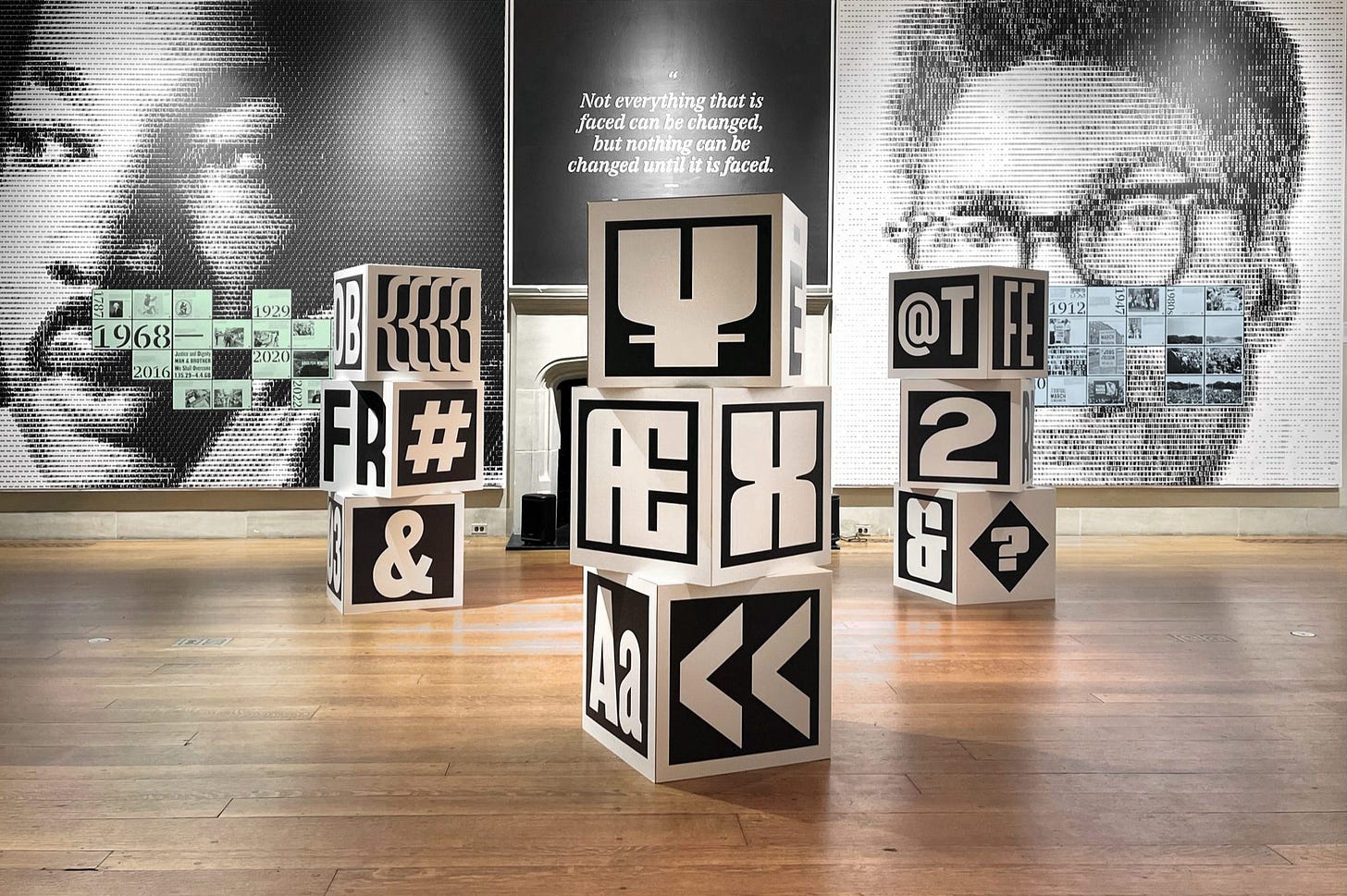
The three core strategies that I’ve been sharing throughout the tour—bumpiness, generosity, and juxtaposition—resonate with all kinds of people and professions. Some of the most unexpected and insightful responses have been in contexts such as Blue Ribbon Studio, Nike’s experimental design lab, and Blue Hill at Stone Barns Center for Food & Agriculture. Turns out that bumpiness is relevant for footwear and food, too.
If I ever do a tour like this again, I will invite co-facilitators for each workshop. I’m grateful for some professors along the way (such as Patrick Gosnell in Clarksville) who helped hold the space with me. In Austin, designer and curator Phillip Niemeyer will be at my side. Phew! Some things are much better as a duo.
The daily practice of making things is a joyous act. Although I preach this to others, it’s easy to forget it for myself, since I don’t have a studio right now and have been on the road teaching for a while. A single day hanging out and printing with the incredible Rick Griffith proved a well-needed reminder. I’m looking forward to some residencies later this year to exercise my making muscle!

Introverts experience group situations very differently than extroverts. This is a useful counterbalance to my constant cheerleading for collaboration. I’ve factored this difference into my teaching for years—incorporating methods such as individual journaling and small group conversations to support multiple learning styles—but curator and artist Lucy Cotter recently urged me to take introversion even more seriously. On her recommendation, I’ve begun to listen to Susan Cain’s Quiet: The Power of Introverts in a World That Can’t Stop Talking as an audiobook. And, as I discovered on this tour: even folks like me who love talking with others need some serious alone time in between!
Lastly, it’s essential to embrace risk within the work of building community and collaboration. adrienne maree brown made this point during our recent conversation in Washington, D.C. There is something inherently vulnerable in being with others whom we don’t know, but it’s also through taking such chances that we open up the possibility of learning something new.

Oh, and one more thing:
Karaoke is still my favorite form for catalyzing vulnerability, trust, and weirdness! When you kick off group karaoke in a packed lecture hall with an awkward but enthusiastic rendition of a song you’ve never done before, it give others license to do the same. But not everyone needs to sing to be part of karaoke—they can also cheer others on, or simply observe quietly. So, rather than asking people what they’d like to sing, I’ve started to pose the question, “What would you like to hear sung in karaoke?” Here are a couple of the hundreds of responses so far:
OK, that’s what I’ve got for now. But before we part ways, let me share a final piece by adrienne maree brown. It’s from her recent book Fables and Spells, a terrific compendium of shorter writings. adrienne calls this “a spell to cast upon meeting a stranger, comrade, or friend working for social and/or environmental justice and liberation”.
radical gratitude spell
you are a miracle in motion
i greet you with wonder
in a world which seeks to own
your joy and your imagination
you have chosen to be free
every day, as a practice.
i can never know
the struggles you went through to get here
but i know you have swum upstream
and at times it has been lonely.
i want you to know
i honor the choices
you made in solitude
and i honor the work
you have done to belong.
i honor your commitment
to that which is larger
than yourself
and your journey
to love the particular vessel of life
that is you.
you are enough
your work is enough
you are needed
your work is sacred
you are here
and i am grateful.
Today, I encourage you to find someone who you think ought to hear this poem, someone who has given a lot of themselves to the world. If you can, read the spell aloud to them, either in person or in a voice recording. I tried this out last week for a dear friend who really needed it, and it seemed to make all the difference. Sometimes the smallest acts are also those that bring the most transformation.
Please wish me luck on the tour ahead. I’m wishing you more love, joy—and, of course, karaoke (or a quiet book, if you prefer)!
With love & light,
Prem
P.S. My first ever crowd selfie, from last week in Clarksville. Hello, world!


